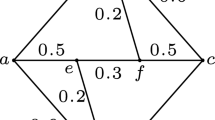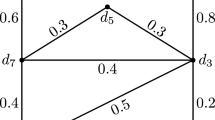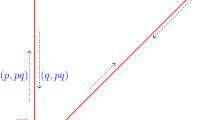Abstract
Average edge connectivity is an important concept in the study of classical graph theory. However, it cannot be applied to the analysis of certain fuzzy problems. To address this problem, we introduce the definition of fuzzy average edge connectivity. In this paper, we study some properties of fuzzy average edge connectivity, including (1) fuzzy average edge connectivity of special fuzzy graphs, (2) fuzzy average edge connectivity of edge-deleted fuzzy subgraphs, (3) the bounds for fuzzy average edge connectivity of fuzzy graphs. In addition, we present algorithms on the connectivity parameter. Finally, practical applications verify the effectiveness of the theory and algorithms in communication networks.











Similar content being viewed by others
Explore related subjects
Discover the latest articles, news and stories from top researchers in related subjects.Data availability
Enquiries about data availability should be directed to the authors.
References
Akram M (2019) m-Polar fuzzy graphs theory, methods and applications. Springer, Cham
Akram M, Siddique S, Ahmad U (2021) Menger’s theorem for m-polar fuzzy graphs and application of m-polar fuzzy edges to road network. J Intell Fuzzy Syst 41(1):1553–1574
Akram M, Siddique S, Alharbi MG (2022) Clustering algorithm with strength of connectedness for m-polar fuzzy network models. Math Biosci Eng 19(1):420–455
Anjali N, Mathew S (2015) On blocks and stars in fuzzy graphs. J Intell Fuzzy Syst 28(4):1659–1665
Banerjee S (1991) An optimal algorithm to find the degrees of connectedness in an undirected edge-weighted graph. Pattern Recognit Lett 12(7):421–424
Bhutani KR (1989) On automorphisms of fuzzy graphs. Pattern Recognit Lett 9(3):159–162
Bhutani KR, Battou A (2003) On m-strong fuzzy graphs. Inf Sci 155(1–2):103–109
Bhutani KR, Rosenfeld A (2003) Fuzzy end nodes in fuzzy graphs. Inf Sci 152:323–326
Bhutani KR, Rosenfeld A (2003) Strong arcs in fuzzy graphs. Inf Sci 152:319–322
Ma JY, Li QG, Zhou XN (2021) Fuzzy edge connectivity and fuzzy local edge connectivity with applications to communication networks. Fuzzy Sets Syst 410:109–125
Manjusha OT, Sunitha MS (2019) Coverings, matchings and paired domination in fuzzy graphs using strong arcs. Iranian J Fuzzy Syst 16(1):145–157
Mathew S, Sunitha MS (2009) Types of arcs in a fuzzy graph. Inf Sci 179(11):1760–1768
Mathew S, Sunitha MS (2010) Node connectivity and arc connectivity of a fuzzy graph. Inf Sci 180(4):519–531
Mathew S, Sunitha MS (2013) Strongest strong cycles and \(\theta -\)fuzzy graphs. IEEE Trans Fuzzy Syst 21(6):1096–1104
Mathew S, Anjali N, Mordeson JN (2018) Transitive blocks and their applications in fuzzy interconnection networks. Fuzzy Sets Syst 352:142–160
Mathew S, Mordeson JN, Malik DS (2018) Fuzzy Graph Theory. Springer
Mathew S, Yang HL, Mathew JK (2018) Saturation in fuzzy graphs. New Math Nat Comput 14:113–128
Nagoorgani A, Malarvizhi J (2009) Isomorphism properties of strong fuzzy graphs. Int J Algorithms, Comput Math 2(1):39–47
Nagoorgani A, Radha K (2008) On regular fuzzy graphs. J Phys Sci 12:33–40
Nagoorgani A, Akram M, Vijayalakshmi P (2016) Certain types of fuzzy sets in a fuzzy graph. Int J Mach Learn Cybern 7(4):573–579
Nair PS (1994) Triangle and parallelogram laws on fuzzy graphs. Pattern Recognit Lett 15:803–805
Poulik S, Ghorial G (2020) Certain indices of graphs under bipolar fuzzy environment with applications. Soft Comput 24:5119–5131
Poulik S, Ghorial G (2021) Determination of journeys order based on graph’s wiener absolute index with bipolar fuzzy information. Inf Sci 545:608–619
Poulik S, Ghorial G (2022) Applications of graph’s complete degree with bipolar fuzzy information. Complex Intell Syst 8:1115–1127
Poulik S, Ghorial G (2022) Estimation of most effected cycles and busiest network route based on complexity function of graph in fuzzy environmen. Artif Intell Rev 55:4557–4574
Poulik S, Ghorial G (2022) New concepts of inverse fuzzy mixed graphs and its application. Granular Comput 7:549–559
Poulik S, Ghorial G, Xin Q (2021) Pragmatic results in taiwan education system based ivfg and ivng. Soft Comput 25:711–724
Rosenfeld A (1975) Fuzzy graphs. fuzzy sets and their applications to cognitive and decision processes. Academic Press, New York
Sarwar M, Akram M, Shahzadi S (2021) Bipolar fuzzy soft information applied to hypergraphs. Soft Comput 25:3417–3439
Sunitha MS, Vijayakumar A (1999) A characterization of fuzzy trees. Inf Sci 113(3–4):293–300
Sunitha MS, Vijayakumar A (2005) Blocks in fuzzy graphs. J Fuzzy Math 13(1):13–23
Yeh RT, Bang SY (1975) Fuzzy relations, fuzzy graphs and their applications to clustering analysis .fuzzy sets and their applications. Academic Press, New York
Acknowledgements
We thank the reviewers for their insightful comments. This work is supported by the Fundamental Research Program of Shanxi Province (No. 202103021223272) and Scientific and Technological Innovation Programs of Higher Education Institutions in Shanxi (No. 2021L305), and Shanxi Scholarship Council of China (No.2020-122), and Research funding of Shanxi Province for outstanding talents (No. 20222003) and Taiyuan University of Science and Technology Scientific Research Initial Funding (No. 20202049).
Funding
The authors have not disclosed any funding.
Author information
Authors and Affiliations
Corresponding author
Ethics declarations
Conflict of interest
There is no conflict of interest between the authors and the institute where the work has been carried out.
Ethical approval
The article does not contain any studies with human participants or animals performed by any of the authors.
Additional information
Publisher's Note
Springer Nature remains neutral with regard to jurisdictional claims in published maps and institutional affiliations.
Rights and permissions
Springer Nature or its licensor (e.g. a society or other partner) holds exclusive rights to this article under a publishing agreement with the author(s) or other rightsholder(s); author self-archiving of the accepted manuscript version of this article is solely governed by the terms of such publishing agreement and applicable law.
About this article
Cite this article
Ma, J., Li, L. & Li, J. Fuzzy average edge connectivity with its application to communication networks. Soft Comput 27, 1367–1378 (2023). https://doi.org/10.1007/s00500-022-07636-1
Accepted:
Published:
Issue Date:
DOI: https://doi.org/10.1007/s00500-022-07636-1





